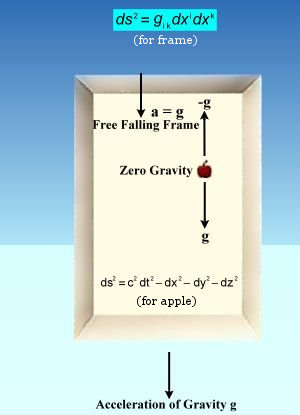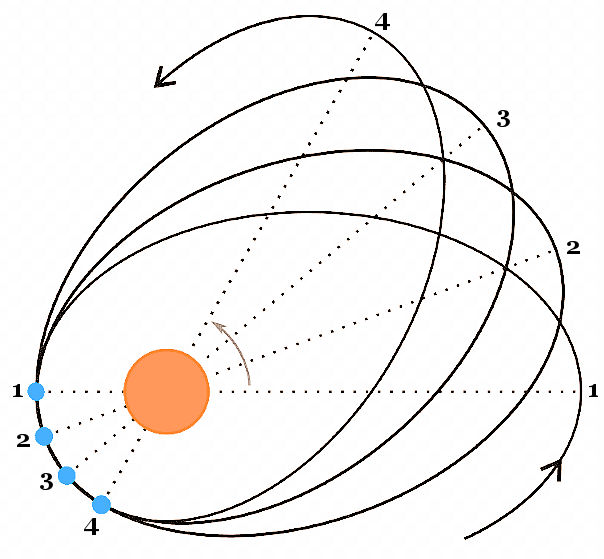

| Home Page | Overview | Site Map | Index | Appendix | Illustration | About | Contact | Update | FAQ |
 |
 |
The inertial frames of reference in both classical mechanics and special relativity move with a constant velocity related to each others. Such arrangement seems to become impossible in the presence of gravity, which produces acceleration (change of velocity). However, there is a class of inertial frames of reference that can be obtained locally by letting it freely falling. This kind of frames would generate an opposite force, which exactly nullifies the acting force. The local region (such as in an elevator) would experience zero gravity as shown in Figure 07a. Figure 07b shows the similar kind of situation in producing gravity with acceleration. |
Figure 07a Free-falling Frame |
Figure 07b Equivalence Principle |
The inter-changeable nature of gravity and acceleration (at least locally) is known as the principle of equivalence. |
 |
As shown in Figure 07b, the principle of equivalence is valid only when the gravitational mass mg is equal to the inertial mass ma. The latest challenge to the theory of General Relativity is about the equality of these quantities. It is suggested that new physics would emerge if they turn out to be un-equal. A modern version of the "leaning tower" experiment (Figure 07c, the one on the left was used by Galileo in 1589) inaugurated in 1990 provides free fall environment up to 9.3 seconds, from which various kinds of atoms have been found to fall at the same rate to accuracies of 11 decimal places. A 2016 project leaded by the French will carry out further measurements in the micro-gravity condition of space to achieve accuracy 100 times better than those from laboratories on Earth. |
Figure 07c Drop Towers, Old and New [view large image] |
The drop tower experiment assumes mg = ma, which implies that all objects accelerate at the constant rate of g = 9.8 m/sec2 if the principle of equivalence is valid. |
 G/c4) (Tik - gikT/2) ---------- (12a)
G/c4) (Tik - gikT/2) ---------- (12a)
| where |  |
is a second rank tensor (Ricci Tensor) related to the curvature of space-time, |
 |
is the Christoffel symbol, and Tik is the energy-momentum tensor (Figure 07e), T its trace. |
 |

|
Figure 07e Energy-Momentum Tensor [view large image] |

|

 ikl (dxk/ds) (dxl/ds) = 0 ---------- (12d)
ikl (dxk/ds) (dxl/ds) = 0 ---------- (12d) iklukul as the "four-force", acting on the particle in the gravitational field. Here, the tensor gik plays the role of the "potential" of the gravitational field - its derivatives determine the field strength
iklukul as the "four-force", acting on the particle in the gravitational field. Here, the tensor gik plays the role of the "potential" of the gravitational field - its derivatives determine the field strength  ikl.
ikl. |
Using the gravitational field equation and the equation of motion, Einstein presented a calculation on the effect of GR on the advance of the perihelion of Mercury: = 6 = 6 GM/(c2a(1 - e2)) ---------- (12e) GM/(c2a(1 - e2)) ---------- (12e)where M is the mass of the Sun, a is the length of the semi-major axis, and e is the eccentricity of the ellipse. In Figure 08, the amount of the advance is greatly exaggerated. The actual advance due to the effect of GR is only 0.43 seconds of arc per year. The most recent and most accurate results seem to be converging towards a value that makes the GR predictions agree well with observation. |
Figure 08 Perihelion Advance [view large image] |